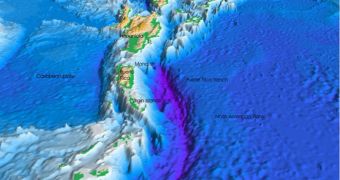Oceanographers have always known that submarine trenches are hot spots for biodiversity, but until not long ago, they only looked at such structures located in the vicinity of landmasses. Now, for the first time ever, a team of researchers from Hawaii has taken a closer look at marine trenches located far out in the Pacific Ocean, near the Hawaii Archipelago. They discovered an unexpected diversity of creatures living within, including megafauna (large creatures), PhysOrg reports.
This class of animals includes sea urchins and cucumbers, crabs, fish and shrimp. In addition, numerous species of simpler organisms were also identified at the studied locations. Overall, some 41 species were found to be living here that were not identified occupying other habitats in the Hawaii region. This means that they have found the necessary conditions inside the trenches, the team says. The new work was conducted by a collaboration of scientists from the Hawaii Pacific University (HPU), and the University of Hawaii at Manoa (UHM).
The group ran the first comprehensive, large-scale survey of the trenches in the region. Details of their investigation and results have been published in a new scientific paper, appearing in the latest issue of the esteemed journal Marine Ecology. The group based its conclusions on 36 dives, conducted using the Pisces IV and Pisces V submersible of the UHM Hawaii Undersea Research Laboratory. Measurements were conducted at depths of between 350 and 1,500 meters, so as to gather the most accurate details possible of what is going on under the surface. The lead author of the paper was HPU professor of marine biology Eric Vetter.
“Perhaps the biggest surprise of this study was the large number of species, 41, that we found only in canyon habitats. This suggests that canyons support a substantial specialized fauna that would not exist in the Hawaiian archipelago in the absence of canyons. Thus, submarine canyons are contributing uniquely to biodiversity in the islands and merit careful attention for environmental protection and management,” concludes UHM professor of oceanography and study coauthor, Craig Smith.

 14 DAY TRIAL //
14 DAY TRIAL //